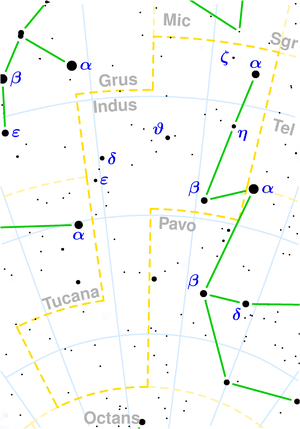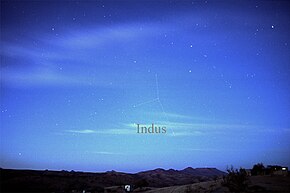Indians (constellation)
|
Constellation indians (indian) |
|
|---|---|
| Latin name | Indus |
| Latin genitive | Indi |
| Abbreviation | Ind |
| Right ascension | 20 h 28 m 41 s to 23 h 27 m 59 s |
| declination | −74 ° 27 ′ 16 ″ to −44 ° 57 ′ 32 ″ |
| surface | 294.006 deg² rank 49 |
| Completely visible | 15.7 ° N to 90 ° S |
| Observation time for Central Europe | not observable |
| Number of stars brighter than 3 mag | 0 |
| Brightest star (size) | α Indi (3.11) |
| Meteor streams | |
|
Neighboring constellations ( clockwise from north ) |
|
| swell | IAU , |
The Indian (occasionally also Indian , Latin Indus, Indianus ) is a constellation of the southern sky.
description

The Indian is a little pronounced constellation. Only two of its stars are brighter than the 4th magnitude . It can be found between the two brightest stars of the constellations crane (Grus) and peacock (Pavo).
The Indian is not visible from Europe. It can only be fully observed from locations south of the 16th parallel .
history
On the first Dutch East India expedition through the Indian Ocean at the end of the 16th century , the navigator Pieter Dirkszoon Keyser was commissioned by the cartographer Petrus Plancius to measure the positions of the bright stars in the southern sky and, with the help of the researcher Frederick de Houtman , including the Indian - "De Indiaen" - a total of twelve new constellations. Plancius took it over for the first time in 1597/1598 on a celestial globe, which was published in 1600 by the cartographer and publisher Jodocus Hondius . On this, the illustrative representation of the "Indus" resembled the picture of a native South Asian. Johann Bayer adopted the twelve new constellations in his 1603 celestial atlas Uranometria .
Also on other older star maps , such as that of Johannes Hevelius from 1690, the “Indus” is depicted as a native without a feather headdress, with a spear in one hand and three more in the other. The feather bonnet of an American Indian did not appear on star maps and celestial globes until the first half of the 18th century.
Celestial objects
Stars
| B. | F. | Names or other designations | Vmag | Lj | Spectral class |
|---|---|---|---|---|---|
| α | 3.11 | 120 | K0 III | ||
| β | 3.67 | 400 | K1 III | ||
| θ | 4.39 | 100 | A5 + A7 | ||
| δ | 4.40 | ||||
| η | 4.51 | ||||
| ε | Epsilon Indi | 4.69 | 11.82 | K4 Vk + T1 V + T6 V | |
| ζ | 4.90 | ||||
| ι | 5.06 | ||||
| μ | 5.17 | ||||
| ν | 5.28 | ||||
| ο | 5.52 | ||||
| κ | 5.62 | ||||
| ρ | 6.04 | ||||
| γ | 6.10 | ||||
| π | 6.17 |
Alpha Indi , the brightest star in the Indian, is a star of the spectral class K0 III, 120 light years away .
The name Alnair is of Arabic origin and means "the enlightened one". The star α Gruis in the constellation crane also bears this name .
β Indi is 400 light years away and belongs to the spectral class K1 II.
At 11.82 light years away, ε Ind is one of the Sun's closest neighbors. It has a low luminosity , which is only about 13% that of our sun. The star is accompanied by a faint brown dwarf .
Double stars
| system | Vmag | distance |
|---|---|---|
| θ | 4.5 / 6.9 | 6.7 arcsec |
| κ | 5.62 / 6.13 |
θ Indi is a binary star system 100 light years away . The two white glowing components can be observed with a small telescope .
NGC objects
| NGC | other | Vmag | Type | Surname |
|---|---|---|---|---|
| 7049 | 10.7 | Galaxy | ||
| 7090 | 10.7 | Galaxy | ||
| 7205 | 10.9 | Galaxy |
In the Indian are the galaxies NGC 7049 , NGC 7090 and NGC 7205 .
See also
Web links
- Günther Bendt: Constellation Indians. In: Astronomie.de; accessed on October 13, 2017
Individual evidence
- ↑ Excerpt from Johann Bayer's Uraniometria with the constellation Indus
- ^ Johannes Hevelius: Prodromus Astronomia - Volume III "Firmamentum Sobiescianum, sive uranographia" - Tavola Emisfero Australe.
- ↑ Jan Mokre: The Indian on the celestial globe. June 1, 2017; accessed on October 13, 2017.

